How to guide: Fix flashing speed of LED indicators
#1
How to guide: Fix flashing speed of LED indicators
Something the Noobs might find useful.
Really simple 10 minute job, trickiest part is getting the right resistor. All the following combos will work if put in parallel with an indicator on each side of the bike.
3x 10w 27ohm - no heat but bulky
2x 10w 15ohm - middle ground - the way to go IMO
1x 10w 8ohm - Gets quite hot if indicating for more than 60 secs.
Stuff you'll need
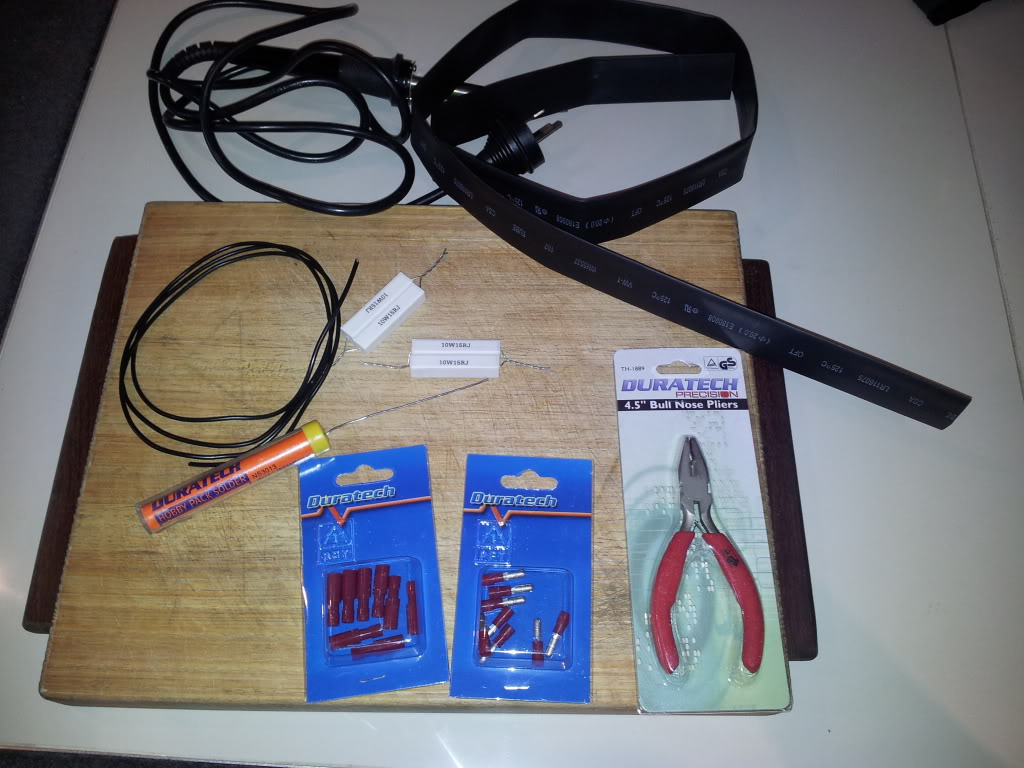
Find your bike
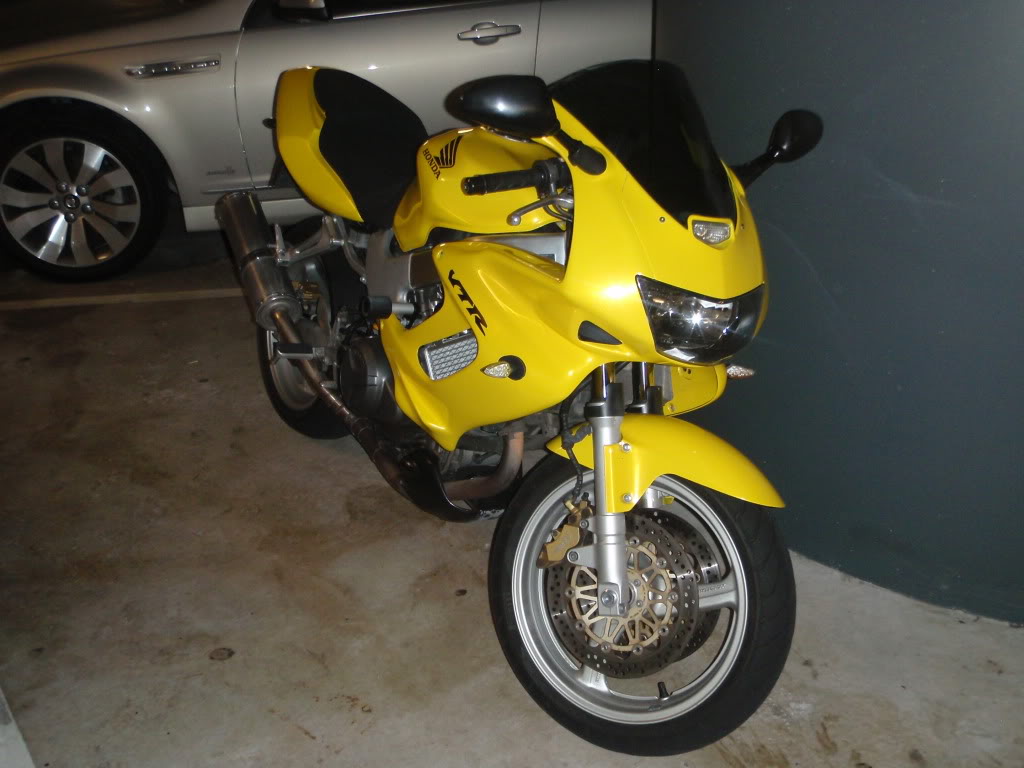
2x 10w 15ohm resistors together
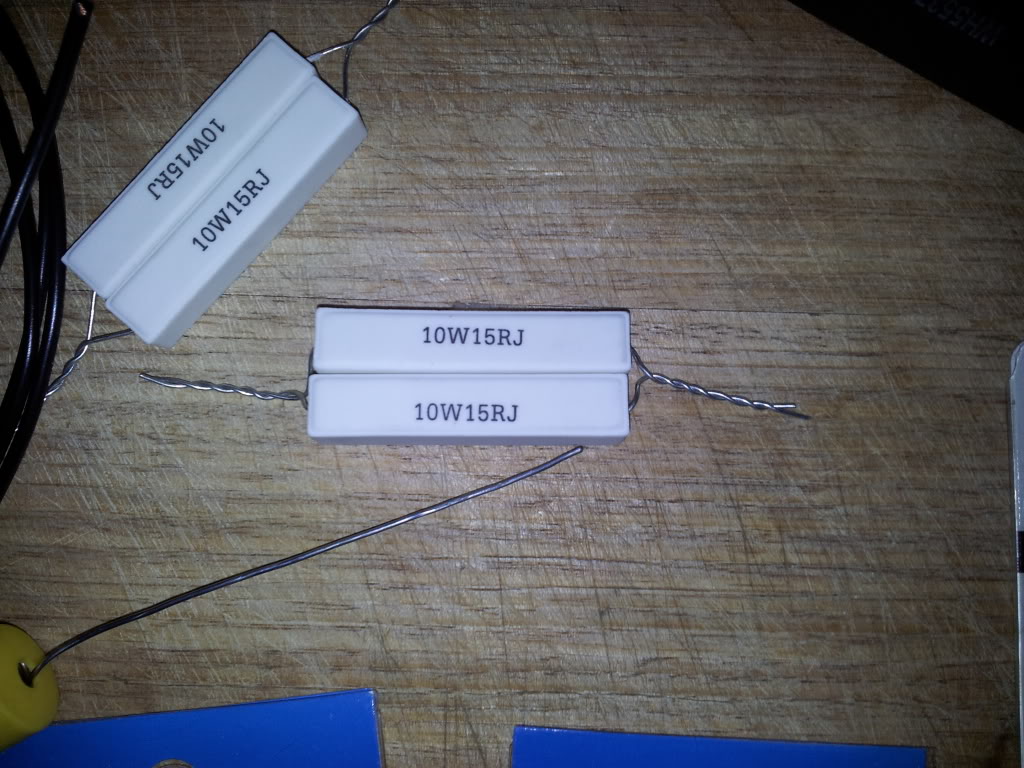
use the appropriate terminals for your bike (bullet in my case) and make up a 'Y' peice with a male and female connector.
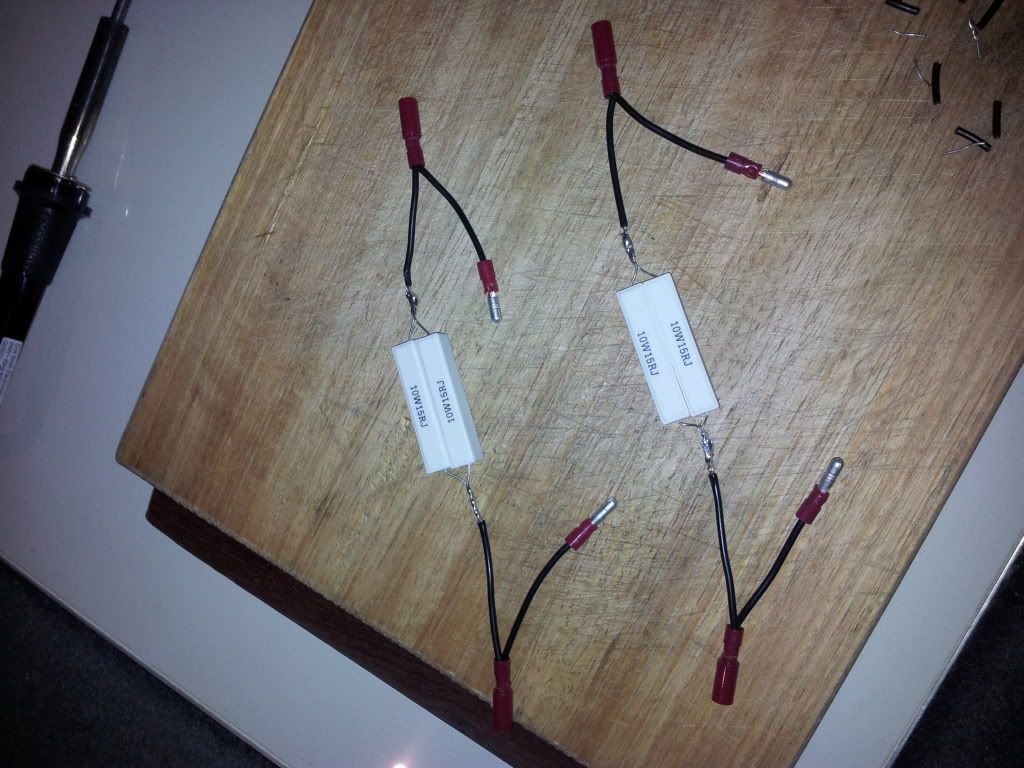
Throw on some shrink-wrap to tidy it up.
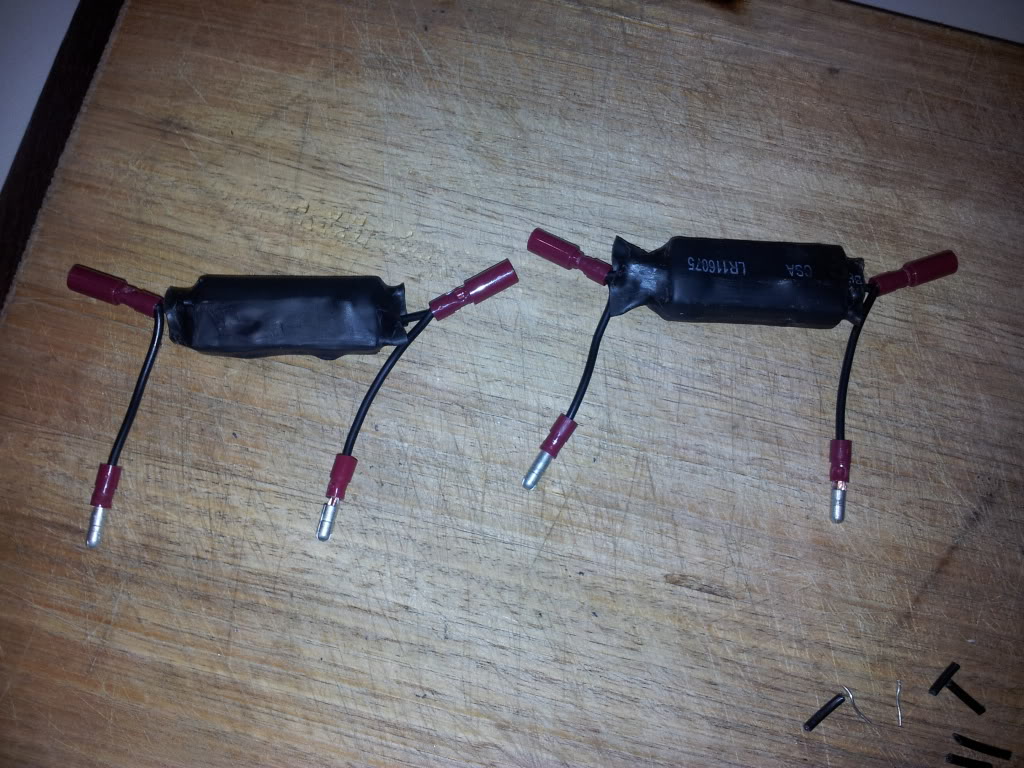
Install in parallel, one unit per side of the bike.
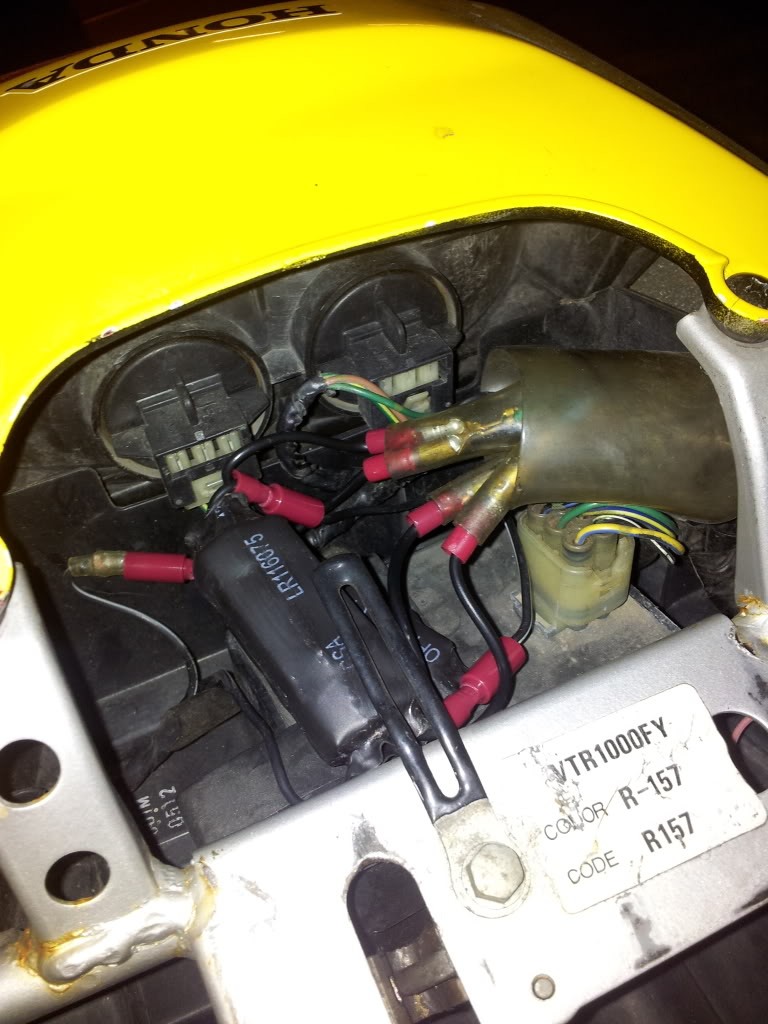
FIXED
Really simple 10 minute job, trickiest part is getting the right resistor. All the following combos will work if put in parallel with an indicator on each side of the bike.
3x 10w 27ohm - no heat but bulky
2x 10w 15ohm - middle ground - the way to go IMO
1x 10w 8ohm - Gets quite hot if indicating for more than 60 secs.
Stuff you'll need

Find your bike

2x 10w 15ohm resistors together

use the appropriate terminals for your bike (bullet in my case) and make up a 'Y' peice with a male and female connector.

Throw on some shrink-wrap to tidy it up.

Install in parallel, one unit per side of the bike.

FIXED
#5
I did mine this exact same way when I got my protons. After thinking about it, one of the advantages of LEDs is low current draw. Using the resistors negates this. A couple of years ago I picked up an electronic flasher, spent a couple of minutes wiring it and only wished I had done it sooner. Plus you can go back to the factory connections on the blinkers and not deal with finding a place to tuck the res. in.
#6
Yeah, thats true buddy. I didnt really care about power usage. i think most people change to LEDS for cosmetics.
Next time id prob spend the time to use a flasher though, mostly to make it neater and to save having the resistors take up space.
Next time id prob spend the time to use a flasher though, mostly to make it neater and to save having the resistors take up space.
#7

If you ever get around to redoing it (open resistor, damaged wires, whatever) you can get some smaller, more compact ones marketed for just this use.
Resistor for Led Turnsignals, HH-68-090, Motorcycle parts.
Newegg.com - (2) Load Resistor Modules / Simulates Load for LED Turn Signal Tail Lights
and tons of others.
Nothing wrong with what you put together... just other options if someone wanted a smaller set up.
Oh and watch where you put those ceramic resistors,,, if you get stuck at a long light or forget and leave your turn signals on, those ceramic resistors will get hot enough to melt fairing plastic and wire insulation. (ask me how I know, I may still have the pictures)
Lastly, some do switch to LEDs to conserve power, to be used in heated gloves or a vest. Not an issue in your parts of AU perhaps.. but it's nice to have as an option in colder climates.
Well done job on what you have put together.
Last edited by E.Marquez; 04-23-2013 at 12:29 PM.
#8
Cheers mate, that setup was on my old yellow vtr, so i can try something else next time.
My current vtr might already have a flasher installed, since it has LED turn signals in the mirrors i think.
Those items you posted do look nice. but $7 or $19 each is ridiculous. The ones i bought were like $0.50 each.
I checked the heat generated from the resistors before i decided how many to use, as i posted in the first few lines. They only got slightly warm after staying on for a few minutes.
Cheers for the encouragement
My current vtr might already have a flasher installed, since it has LED turn signals in the mirrors i think.
Those items you posted do look nice. but $7 or $19 each is ridiculous. The ones i bought were like $0.50 each.
I checked the heat generated from the resistors before i decided how many to use, as i posted in the first few lines. They only got slightly warm after staying on for a few minutes.
Cheers for the encouragement
#9
I did the same a few months ago, but the resistor made every set of LED lights way to dim. I tried two different resistors 50w and 25w on two separate sets of lights. How dim did your lights turned out after you added the resistors? I should try the 20w... thanks
#10
You could buy this to replace your stock flasher unit and be done with it:
LF1-S-FLAT from Super Brite LEDs Inc.
LF1-S-FLAT Universal Motorcycle Electronic Flasher | Flashers & Load Resistors | Car Bulb Installation Supplies | LED Car Bulbs | Super Bright LEDs
LF1-S-FLAT from Super Brite LEDs Inc.
LF1-S-FLAT Universal Motorcycle Electronic Flasher | Flashers & Load Resistors | Car Bulb Installation Supplies | LED Car Bulbs | Super Bright LEDs
#11
@Codeblue: I think you did a great job there. I also think its better than buying a flasher. About saving space, I agree with E.Marquez's advise. I am pretty sure, its still working just fine and would go for quite longer time than the easily available flashers. @E.Marquez: Very useful advise on saving power with LEDs and safe instalation advises.
#12
Well... Let me start by saying the OP did a nice clean work of it, and it's a very good choice to go that route... But then, there are a few things to note...
The "resistors" aren't actually plain run of the mill resistors as such... Adding that will just make the LED's dim... If they look like in the images, they are the same type, and hooked up correct works fine... If they look different, they are different...
Uh... How about no... Sometimes it just helps to know what you are talking about... Why should they last longer than a flasher? Any particular reason you would like to mention?
A "flasher" as in the oldschool type with moving parts, does NOT, in any way work with LED's... Not unless you add resistors like above... You can't make a mechanical flasher have the correct blink rate with a LED...
The only type that works are actually load independant flashers, which are made up of non moving parts... IC's... And they have the same theoretical lifespan as those resistors... Period... Not longer, not shorter... They are plug in replacements for the stock flasher, and hence they save both space, power and reduces the chance of problems due to corrsion at the different connecting points along the way...
Plain and simple, more money, but a better solution in terms of reliability...
@Codeblue: I think you did a great job there. I also think its better than buying a flasher. About saving space, I agree with E.Marquez's advise. I am pretty sure, its still working just fine and would go for quite longer time than the easily available flashers. @E.Marquez: Very useful advise on saving power with LEDs and safe instalation advises.
A "flasher" as in the oldschool type with moving parts, does NOT, in any way work with LED's... Not unless you add resistors like above... You can't make a mechanical flasher have the correct blink rate with a LED...
The only type that works are actually load independant flashers, which are made up of non moving parts... IC's... And they have the same theoretical lifespan as those resistors... Period... Not longer, not shorter... They are plug in replacements for the stock flasher, and hence they save both space, power and reduces the chance of problems due to corrsion at the different connecting points along the way...
Plain and simple, more money, but a better solution in terms of reliability...
Thread
Thread Starter
Forum
Replies
Last Post
Randman
Modifications - Cosmetic
3
06-12-2006 08:01 PM













